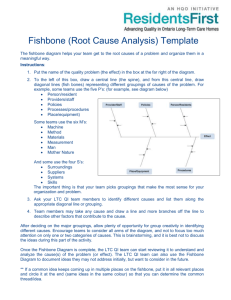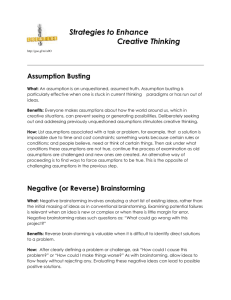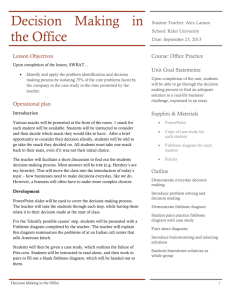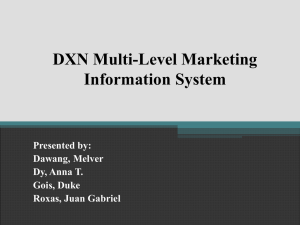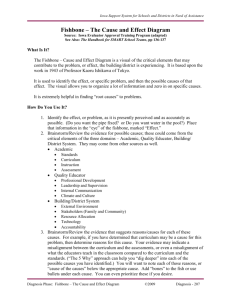Go Fish! Exploring Root Cause Analysis
advertisement
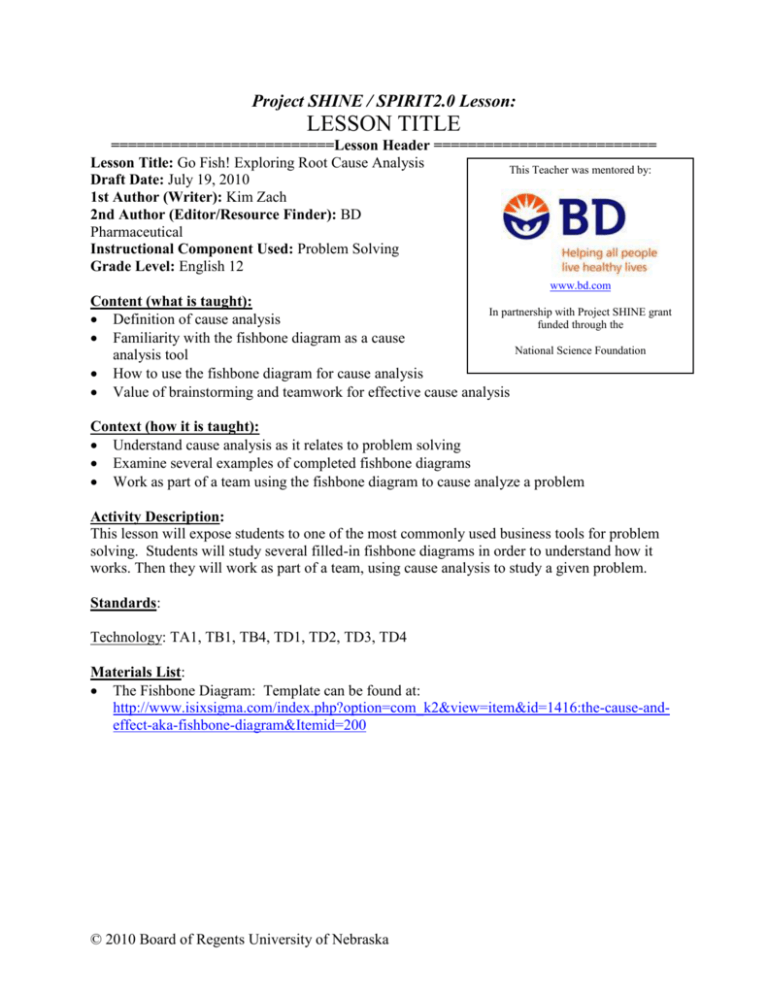
Project SHINE / SPIRIT2.0 Lesson: LESSON TITLE ==========================Lesson Header ========================== Lesson Title: Go Fish! Exploring Root Cause Analysis This Teacher was mentored by: Draft Date: July 19, 2010 1st Author (Writer): Kim Zach 2nd Author (Editor/Resource Finder): BD Pharmaceutical Instructional Component Used: Problem Solving Grade Level: English 12 www.bd.com Content (what is taught): In partnership with Project SHINE grant Definition of cause analysis funded through the Familiarity with the fishbone diagram as a cause National Science Foundation analysis tool How to use the fishbone diagram for cause analysis Value of brainstorming and teamwork for effective cause analysis Context (how it is taught): Understand cause analysis as it relates to problem solving Examine several examples of completed fishbone diagrams Work as part of a team using the fishbone diagram to cause analyze a problem Activity Description: This lesson will expose students to one of the most commonly used business tools for problem solving. Students will study several filled-in fishbone diagrams in order to understand how it works. Then they will work as part of a team, using cause analysis to study a given problem. Standards: Technology: TA1, TB1, TB4, TD1, TD2, TD3, TD4 Materials List: The Fishbone Diagram: Template can be found at: http://www.isixsigma.com/index.php?option=com_k2&view=item&id=1416:the-cause-andeffect-aka-fishbone-diagram&Itemid=200 © 2010 Board of Regents University of Nebraska Asking Questions: (Go Fish! Exploring Root Cause Analysis) Summary: The questions will set up the lesson and get students thinking about problem solving as a process, cause analysis as an early step in that process, and the advantages of a team approach to cause analysis. Outline: Students will examine their own knowledge of problem solving strategies. Students will come up with a definition of cause analysis and think how it could be part of the problem solving process. Students will discuss the value of brainstorming as a team when looking at a problem for its root causes. Activity: Students will answer their questions (below) on a survey sheet first and then use their answers to engage in group discussion to share their ideas. Questions When you face a problem, how do you go about seeking a solution? Have you ever thought of problem solving as a process? What is meant by process? What might be the first step in solving a problem? What do you think the phrase “cause analysis” have to do with problem solving? How would brainstorming a number of causes help when faced with a problem? How might a team brainstorming session be of help in a problem solving situation? © 2010 Board of Regents University of Nebraska Answers Exploring Concepts: (Go Fish! Exploring Root Cause Analysis) Summary: Students will explore the concept of cause analysis as it relates to problem solving. They will get an idea of how the process works by examining several examples of filled-in fishbone diagrams. Outline: Students will explore the theory behind root cause analysis as a problem solving tool. Students will examine several examples of fishbone diagrams used for specific problems. Activity: The teacher will explain what root cause analysis is, how it was developed, and ways it can be used for problem solving through slide shows and other materials. Students will also look at a variety of completed fishbone diagrams to visualize how the process works. Resources: Teacher Selected Materials How to Use the Ishikawa Fishbone Diagram to Determine Cause and Effect: http://business.1howto.com/Management/Determine.Cause.Effect.html Mind Tools: Cause and Effect Diagrams: http://www.mindtools.com/pages/article/newTMC_03.htm>. Root Cause Analysis: http://www.au.af.mil/au/awc/awcgate/awc-thkg.htm#rootcauseanalysis (links to two slideshows) Try This Powerful Problem Solving Tool: http://www.frahme.com/fishbone.htm © 2010 Board of Regents University of Nebraska Instructing Concepts: (Go Fish! Exploring Root Cause Analysis) Problem Solving Problem Solving Process The problem solving process is teachable and students will become better problem solvers with guidance and practice. Since there are many problem solving models, it depends who you talk to about which model is best. George Polya first outlined one of the best-known problem solving processes. This instructional piece will focus on Polya’s work. Step One: Understand the Problem This step involves the very beginning of the problem solving process. Students are asked to carefully analyze the problem paying particular attention to these questions. Are all the words in the problem known to you? What are you supposed to find, solve for, show, or prove? Is it possible to restate the problem in your own words? Is there a picture, graph or diagram that can help you understand the problem? Is there enough information to solve the problem? Step Two: Devise a Plan This step involves the process of deciding how you are going to solve the problem and creation of a plan that will lead to that solution. Below are some possible strategies that students might want to consider. Guess and check, look for a pattern, draw a picture, make a list Solve a simpler problem Think about problems that are similar you might have solved before Compare and contrast Use a model Solve an equation or work backward This list of strategies is not all-inclusive. One of the most important strategies is to be creative and think “outside” the box to try to devise new and different ideas that may apply. Step Three: Carry out the Plan This step is easier than step two because you just have to stick to the plan you created. Work carefully and diligently to attempt the plan you have devised. If your plan doesn’t work go back to step two and use the knowledge you have gained to think of something else. Often we learn more from a failure than by solving a problem correctly the first time. Step Four: Looking Back This step is very important to becoming better problem solvers. It is this analysis of what worked and what didn’t work that lets you apply knowledge in similar situations and extend into the less familiar. You should think about where you might use the method again and think about how your strategy could be improved upon. This analysis of what happened will make problem solving easier in the future. © 2010 Board of Regents University of Nebraska Organizing Learning: (Go Fish! Exploring Root Cause Analysis) Summary: Students will practice cause analysis by using the fishbone diagram to examine the possible causes behind a selected problem. Outline: Using the fishbone diagram, students will work in small groups to cause analyze a given problem. Students will come together as a large group and compare the results of each small group’s cause analysis. Activity: In this lesson, students will have the opportunity to work in small teams and practice using the fishbone diagram. Each group will be assigned the same problem (school-related) and work through the process of determining possible causes. Following this, they will meet as a larger group to compare results. Resources: Large sheets of paper, tape, and markers Suggested problems teachers could use that are school related o Why aren’t more students involved with the speech team (or band, once-act, whatever activity in that school needs more involvement)? o Why are students having difficulty staying awake in first and second period classes? o Why aren’t more students reading for pleasure? o Why are students experiencing stress? © 2010 Board of Regents University of Nebraska Understanding Learning: (Go Fish! Exploring Root Cause Analysis) Summary: Students will engage in several assessment activities that will demonstrate their understanding of root cause analysis and its place in the problem solving process. Outline: Formative questions of cause analysis/problem solving Summative activities of cause analysis/problem solving Activity: Students will do several performance activities relating to the cause analysis aspect of problem solving. Formative Assessment As students are engaged in the lesson ask these or similar questions: 1) What is root cause analysis? 2) What is the fishbone diagram and how is it used in cause analysis? 3) Why is cause analysis a critical step in the problem solving process? 4) How does cause analysis benefit from a team approach? Summative Assessment Students will work in small groups to complete these activities: 1) Create a list of at least five problems that students in your school face or that the school itself faces. (Problem Solving—Understanding the Problem) 2) Choose one of those problems and work through the cause analysis process, using the fishbone diagram. (Problem Solving—Understanding the Problem) © 2010 Board of Regents University of Nebraska

